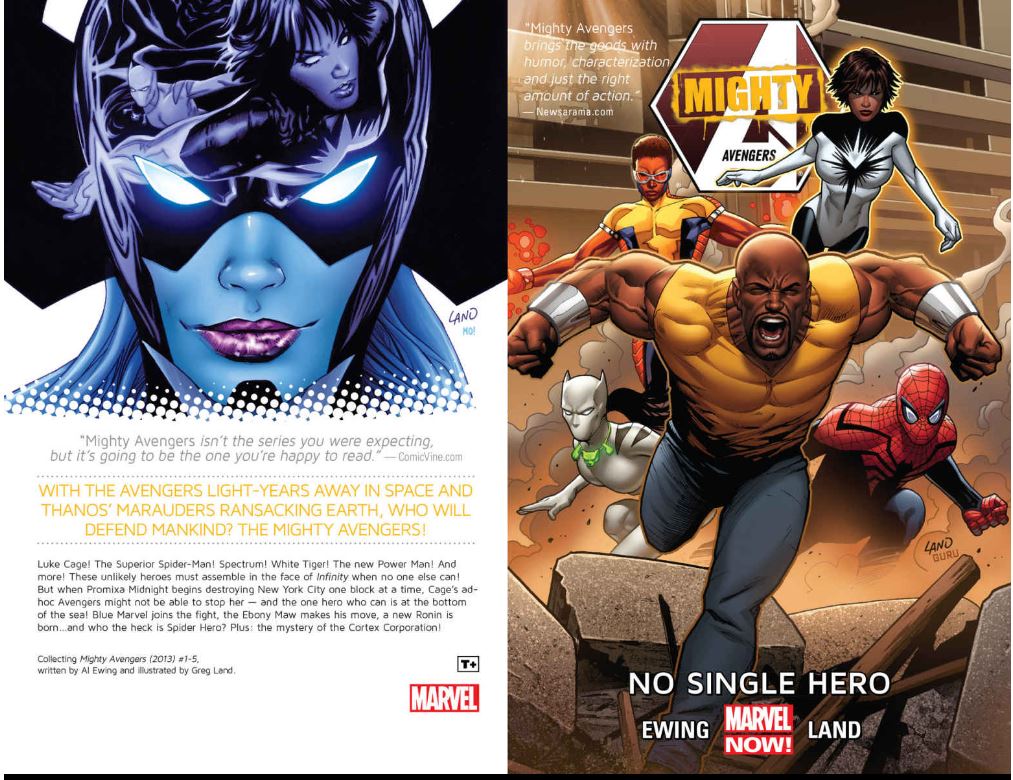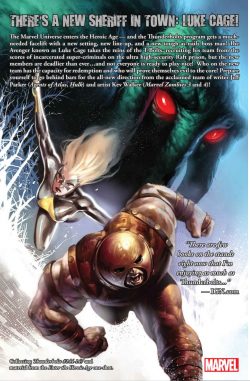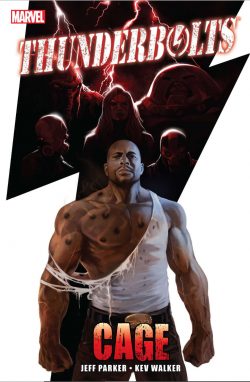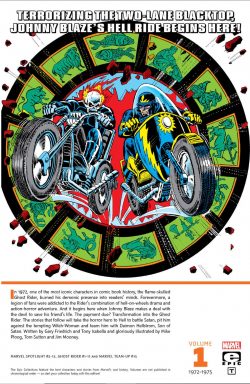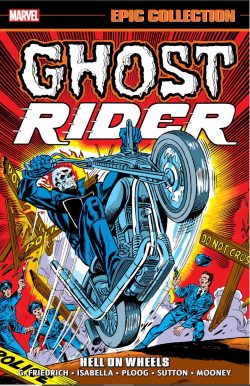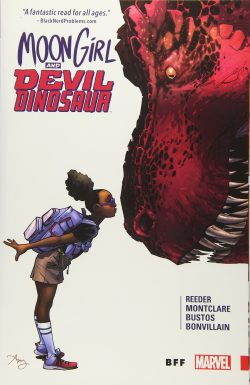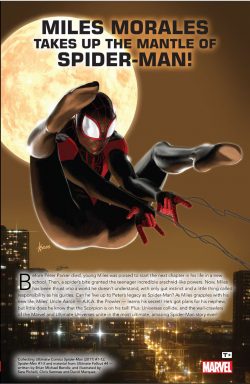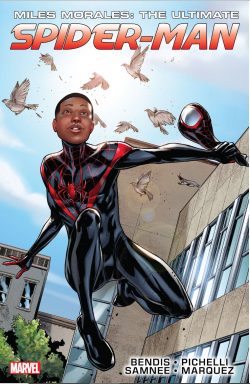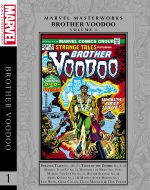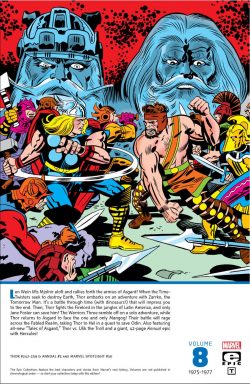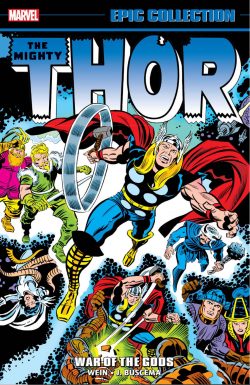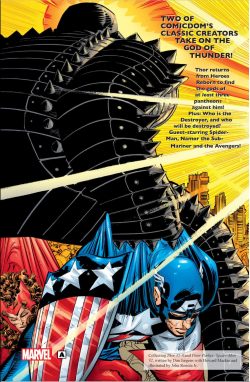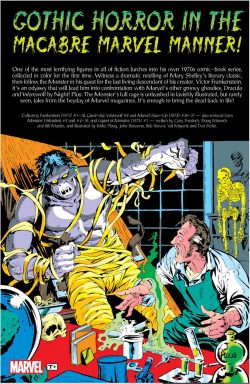
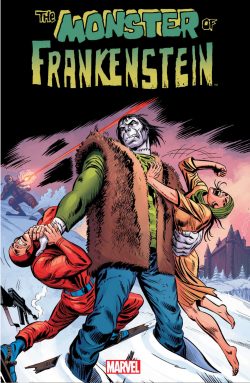
By Gary Friedrich, Doug Moench, Bill Mantlo, Gerry Conway, Mike Ploog, John Buscema, Bob Brown, Val Mayerik, Don Perlin, Sal Buscema & various (Marvel)
ISBN: 978-0-7851-9906-9 (TPB/Digital edition)
Whereas DC Comics capitalised on the early 1970s global boom in all things supernatural and mystic by creating a plethora of short-story anthologies and the occasional spooky star, Marvel Comics took the trend in another direction and created a small army of horror-heroes to headline their own series.
This particular collection reprints the House of Ideas’ interpretation of the Mary Shelley classic from a time when the censorious Comics Code Authority first loosened some of its strictures banning horror material from the pages of comics. That translates here to 18 issues of the colour comicbook; Giant-Sized Werewolf #2, Marvel Team-Up #36-37 and all the pertinent strips from adult-oriented Marvel magazines Monsters Unleashed #2, 4-7, 9-10 and one-shot Legion of Monsters (spanning January 1973-September 1975), all awaiting your rapt attentions.
Some comic artists work best in black-&-white. Such is certainly the case with Mike Ploog. A young find who had previously worked with Will Eisner, Ploog illustrated Gary Friedrich’s pithy adaptation of the original novel before moving on to groundbreaking new ventures as the strip graduated to in-house originated material. This monumental tome is presented mostly in colour, but if you are of a similar opinion you could try to lay your hands on the 2004 monochrome Essential Monster of Frankenstein edition…
Cover-dated January 1973, ‘Mary Shelley’s Frankenstein!’ introduced Robert Walton IV, great grandson of the sea-captain who had rescued scientist Victor Frankenstein from the polar ice and who was subsequently regaled with the incredible tale of “the Modern Prometheus”.
Now, in 1898 and leading a band of rogues, cutthroats and sullen Inuit, Walton finds the fabled monster interred in a frozen slab and brings it aboard his ice-breaker. He then recounts the story to his fascinated cabin-boy, unaware of the fear and discontent simmering below decks…
A bloody mutiny during a terrible gale opens the second issue as the burning ship founders. Meanwhile the flashbacked saga of tragic Victor reaches the terrible moment when the monster demanded a mate. The guilt-plagued scientist complied only to baulk at the last and destroy his second creation. ‘Bride of the Monster!’ concludes with the creature’s fearsome vengeance on his creator, paralleling the grim fate of the storm-tossed ship…
In The Monster of Frankenstein #3, ‘The Monster’s Revenge!’ has the reawakened creature freed from its ice-block to overhear the continuation of his life-story from Walton’s lips, even as the last survivors struggle to find safety in the Arctic wastes.
Thereafter ‘Death of the Monster!’ – with inker John Verpoorten taking some of the deadline pressure off hard-pressed Ploog – turns the tables as the monster reveals what happened after the polar showdown with his creator, leading to a new beginning as Walton reveals that not all the Frankensteins were eradicated by the Monster’s campaign of vengeance. Their warped blood-line lives on…
A new direction began with issue #5 in ‘The Monster Walks Among Us!’. Making his way south, the tragic creature arrives in a Scandinavian village in time to save a young woman from being burned at the stake on a blazing longboat, only to rediscover that when villagers pick up pitchforks and torches to go a-screamin’ and a-hollerin’ for blood, they generally have a good reason…
With issue #6 the comic book renamed itself The Frankenstein Monster as the undying creature reaches the village of Ingolstadt a century after he first wreaked bloody vengeance on his creator’s loved ones.
‘…In Search of the Last Frankenstein!’ is a mini-classic of vintage horrors scripted as usual by Friedrich but plotted, pencilled & inked by Ploog, who was reaching an early peak in his artistic career. It was also his last issue.
Ploog was followed by John Buscema & Bob Brown before Val Mayerik settled as regular artist whilst Friedrich gave way to Doug Moench, a writer once synonymous with Marvel’s horror line.
Issues #7, 8 and 9 bowed to the inevitable, pitting the Monster against Marvel’s top horror star (albeit 75-ish years prior to his contemporary adventures). Beginning with ‘The Fury of a Fiend!’ continuing in ‘My Name is… Dracula!’ and concluding with ‘The Vampire Killers!’, this is an extremely classy tribute to the old Universal movies and then-current Hammer Films in equal measure, wherein the misunderstood misanthrope battled an undying evil for ungrateful humanity, consequently losing the power of speech; and becoming more monstrous in the process.
Produced by Friedrich, Buscema and Verpoorten, this trilogy lacks the atmosphere of Ploog’s tenure, but the action is very much in the company’s house-style. With #10 (inked by Frank Giacoia and Mike Esposito) the creature finally found ‘The Last Frankenstein!’ …much to his regret.
With number #11’s ‘…And in the End…!?’ – illustrated by Brown & Vince Colletta – and #12’s ‘A Cold and Lasting Tomb’ (Moench, Mayerik and Colletta), the Monster wrapped up his historical adventures by falling into a glacial sea. Frozen once again into another block of ice he was revived, Captain America-style, in modern times: i.e. the swinging 1970s…
The epic account then switches to monochrome as more mature episodes from Monsters Unleashed begin, starting with #2 and ‘Frankenstein 1973’ by Friedrich, Buscema & Syd Shores. Here we see how an obsessive young man finds the Monster preserved as a carnival exhibit, only to see his jealous girlfriend revive it whilst trying to burn down the sideshow. The story continued in #4 as ‘Frankenstein 1973: Chapter Two – The Classic Monster’ (Friedrich, Buscema & Win Mortimer), with a literal mad scientist actually putting his own brain in the monster’s skull. Happily, the unnatural order is restored in ‘Once a Monster…’
Monsters Unleashed #6 introduced new creative team Doug Moench & Val Mayerik who completed the introduction to modern times with a good old-fashioned monster hunt in ‘…Always a Monster!’
This leads directly to #7’s ‘A Tale of Two Monsters!’: a dark, socially relevant tale of the modern underclass and man-made horrors carried over into ‘Frankenstein 1974: Fever in the Freak House’ before concluding in #9’s ‘The Conscience of the Creature’.
The horror boom was fading by this time and Monsters Unleashed #10 was the Monster’s last outing there: a superbly dark and sardonic Christmas offering complete with elves, snow, terrorists and a Presidential assassination attempt.
One final monochrome tale from Moench, Mayerik, Dan Adkins & Pablo Marcos (accompanied by a chilling frontispiece by Marcos) appeared in 1975 one-shot The Legion of Monsters. ‘The Monster and the Masque’ was a bittersweet morality play seeing the creature accidentally accepted at a fancy dress party, which is ruined when a different sort of monster gets carried away…
Switching back to full-colour comics, next up is a rather tame team-up/clash from Giant-Size Werewolf #2 wherein ‘The Frankenstein Monster Meets Werewolf by Night’ (Moench, Don Perlin & Colletta) to collaterally combine and quash a band of run-of-the-mill West Coast Satanists.
Resuming his own series, The Frankenstein Monster #13 displays ‘All Pieces of Fear!’ (Moench, Mayerik & Jack Abel) as, shoe-horned into mid-1970s America, the Monster is drawn into a tale heavy with irony as men act like beasts and an obsessive father ignores his family whilst building his own abominations through the nascent science of cloning.
With a hip young teenager as sidekick/spokesperson, ‘Fury of the Night-Creature’ (Dan Green inks) extends the saga by introducing I.C.O.N. (International Crime Organizations Nexus): yet another secret organisation intent on conquest by merging corporate business practices with traditional gangsterism.
Issue #15’s ‘Tactics of Death’ (Klaus Janson inks) briefly concludes the acronym-agenda as the Monster and companion Ralph mop up the men in suits only to be shanghaied to Switzerland to meet the latest Last-of-the-Frankensteins in ‘Code-name: Berserker!’ (inked by Bob McLeod – who managed to handle the next issue too).
Veronica Frankenstein was still absorbed in the family business, but claimed to be fixing her ancestors’ mistakes when I.C.O.N. creeps showed up, demanding her biological techniques in ‘A Phoenix Beserk!’. Beautifully inked by Mayerik and Adkins, the last colour issue ended on a never-to-be completed cliffhanger (although scripter Bill Mantlo covered elements of the story in Iron Man some years later) as the Monster and his new friend met ‘The Lady of the House’ – the utterly bonkers creature-crafter dubbed Victoria Von Frankenstein…
Perhaps the abrupt cancellation was a mercy-killing after all…
Rounding off the narrative wonderment is a 2-part tale from Gerry Conway, Sal Buscema & Colletta first seen in Marvel Team-Up #36-37 wherein Spider-Man is kidnapped and shipped off to Switzerland by the assuredly insane Baron Ludwig Von Shtupf, who proudly proclaims himself The Monster Maker…
In ‘Once Upon a Time, in a Castle…’ the bonkers biologist wants to pick-&-mix creature traits – having already secured the Frankenstein Monster to practise on… After the webslinger busts them both out, they stumble upon sexy SHIELD Agent Klemmer, but a rapid counterattack goes badly wrong when Von Shtupf unleashes his other captive – the furiously feral Man-Wolf – and only big Frankie can prevent a wave of ‘Snow Death!’
This codex of comic creepiness concludes with a mammoth bonus section offering art lovers and funnybook historians additional treats such as Ploog’s very first design sketch of the monster from 1972, original art, illustrations and (finished but pre-editorial addition) painted covers by Boris Vallejo.
Also on show are assorted frontispieces, pencils, inks and previous collected editions, covers and original art by Tom Sutton, Gray Morrow, Vince Evans, Mayerik, Bernie Wrightson & Arthur Adams, making this compendium a perfect treat for fantasy fans and dedicated horrorists: one that should be a first choice for introducing scare-loving civilians to the world of comics.
© 1973, 1974, 1975, 2015 Marvel Characters, Inc. All Rights Reserved.

